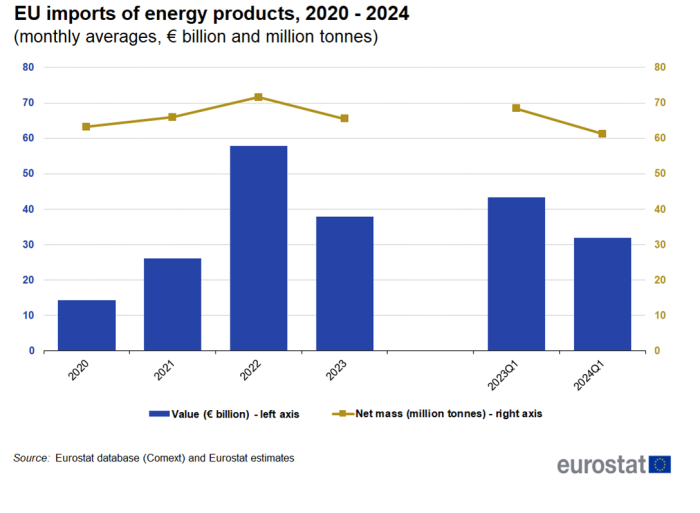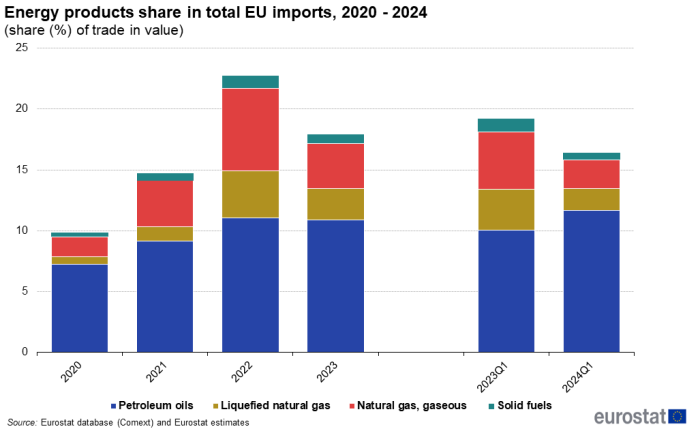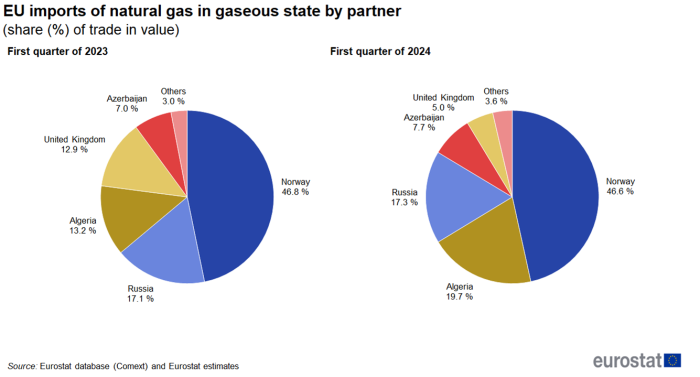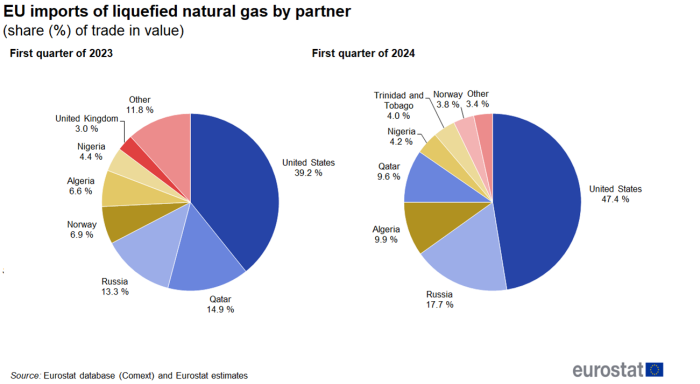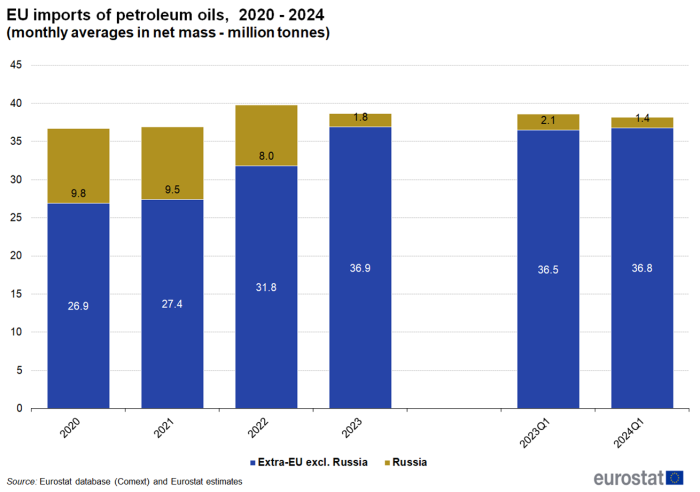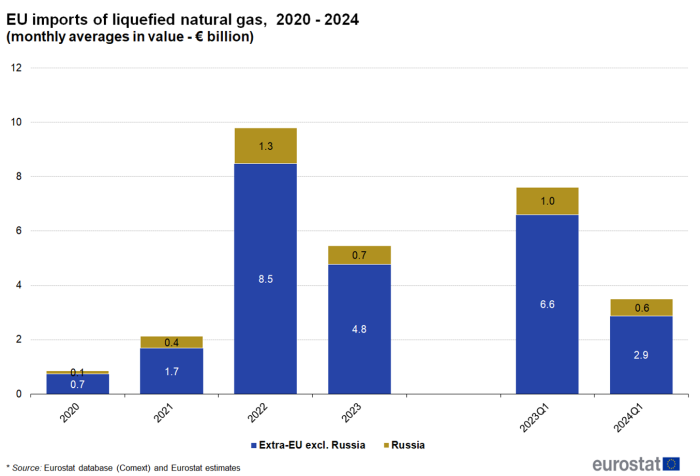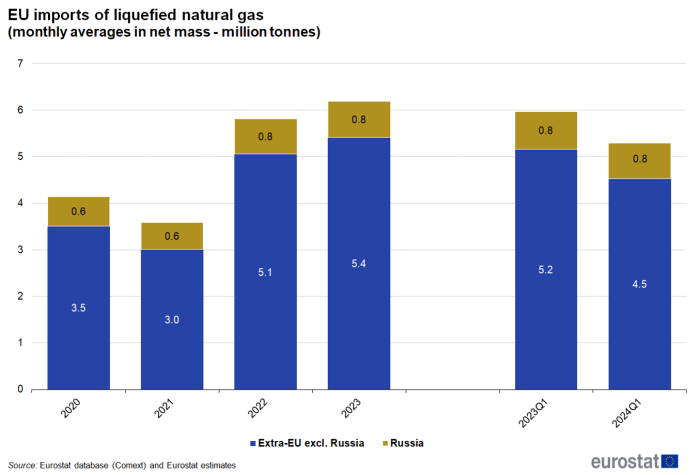EU imports of energy products - latest developments
Data extracted in June 2024.
Planned article update: September 2024.
Highlights
EU imports of energy products decreased in the first quarter of 2024 compared to the same quarter of 2023, both in value and quantity.
In the first quarter of 2024 compared to the same quarter of 2023, EU imports of natural gas in gaseous state decreased in volume (-12 % ) but more in value (-57 %) as prices decreased.
In the first quarter of 2024 compared to the same quarter of 2023, EU imports of liquefied natural gas decreased both in volume (-11 % ) but much more in values (-54 %) as prices decreased.
This article provides a picture of trade in energy products between the European Union (EU) and the rest of the world (extra-EU trade). The analysis focuses on yearly data for the period 2020-2024, with a view on the fourth quarters of 2022 and 2023, thus reflecting the most recent developments. Until the end of 2021, Russia was the main supplier of petroleum oils and natural gas to the EU. After Russia's invasion of Ukraine, the European Union reacted with several packages of sanctions, which directly and indirectly affected the trade of oils and natural gas. A major diversification of suppliers started to emerge progressively in the following period.
The article shows data on trade in value (expressed in millions of euros) and net mass (weight expressed in tonnes). Supplementary information like trade in terajoules of natural gas can be found in Eurostat databases. The energy products considered in this article are petroleum oils (petroleum oils from natural gas condensates and petroleum oils obtained from bituminous minerals, crude), natural gas (liquefied and in gaseous state) and solid fuels (coal, lignite, peat and coke).
This article is part of an online publication providing recent statistics on international trade in goods, covering information on the EU's main partners, main products traded, specific characteristics of trade as well as background information.
Full article
Overview
The analysis of the latest data shows a decline in the first quarter of 2024 compared with the same quarter of 2023. This continues the trend seen from 2022 to 2023. In the first quarter 2024, with respect to the same quarter in 2023, the decrease in values is 26.4 %. The net mass also dropped significantly, decreasing 10.4 %. In the whole year 2023 compared to 2022, average monthly values dropped by 34.4 % while the net mass dropped by 8.4 %.
For the energy products analysed in this article, Figure 2 shows, their share on total EU imports in the years 2020-2023 and in the first quarters of 2023 and 2024. The significant fluctuations observed are the consequence of strong volatility of their prices. The share of petroleum oils in the total of EU imports grew 1.7 percentage points (pp) in the first quarter of 2024 compared to the first quarter of 2023. In contrast, the share for liquefied natural gas and natural gas in gaseous state, decreased by 1.6 pp and 2.3 pp respectively in this period.
Figure 3 shows the evolution of the imports of energy products since the first quarter of 2022. In the first quarter of 2024 imports of petroleum remained stable compared to the quarter before. In this last quarter, there were modest decreases for coal (-4 %) and natural gas in gaseous state(-6 %) and a somewhat larger decrease for liquefied natural gas (-13 %). Since the start of 2022, imports of coal increased until the second quarter of 2023 when they significantly decreased. The imports of natural gas in gaseous state decreased progressively in 2022 and in the first quarter of 2024 were 34 % lower compared to the value in the first quarter of 2022. The imports of liquefied gas significantly increased until the second quarter of 2023 but between then and the first quarter of 2024 dropped 27 pp. The increased popularity of liquefied natural gas could be explained by certain factors, such as ease of transport, higher efficiency and cleaner use compared to other sources of energy.
Main suppliers of petroleum oils, natural gas and coal to the EU
Russia's invasion of Ukraine led to significant changes in the share of the main partners because of several sanctions directly and indirectly affecting the imports of energy products.
Russia had been the largest supplier of petroleum oils to the EU in the in the fourth quarter of 2021 with a share of 24.8 %. With regard to petroleum oils, the EU ban on seaborne imports of Russian crude oil entered into force on 5 December 2022, followed by the embargo on refined oil products as of 5 February 2023. The impact of these measures is indirectly visible in Figure 4 where Russia is no longer among the seven main partners. In the first quarter of 2024, the United States (17.1 %), Norway (13.6 %) and Kazakhstan (10.9 %) were the largest partners. The largest increase between the first quarter of 2023 and 2024, was seen in the share of the United States (+3.9 (pp)).
Norway was the largest supplier of natural gas in gaseous state to the EU in the in the first quarter of 2024 with a share of 46.6 % - see Figure 5. It was followed by Algeria (19.7 %) whose share increased by 6.6 pp. By contrast the share of the United Kingdom dropped by 7.8 pp.
In the first quarter of 2024 compared to the first quarter of 2023 Russia's share in EU import of liquefied natural gas increased by 4.4 pp (see Figure 6), despite falling in absolute terms as shown later in Figure 12. In the first quarter of 2024 Russia (17.7 %) was the EU's second largest supplier of liquefied natural gas behind the United States (47.4 %). In this period, the share of Qatar (-5.3 pp) dropped most while the shares of Algeria (+3.3 pp) and the United States (+8.2 pp) increased.
Russia had been the largest supplier of coal to the EU in the in the fourth quarter of 2021 with a share of 47.9 %. However, the fifth package of EU sanctions imposed a prohibition to purchase, import or transfer coal and other solid fossil fuels into the EU if they originate in Russia or are exported from Russia. As consequence Russia's share in EU imports of coal dropped to zero in the fourth quarter of 2022. Between the first quarters of 2023 and 2024, the shares of Australia (+11.8 pp) and the United States (+9.2 pp) increased while the shares of South Africa (-10.2 pp) and Colombia (-8.8 pp) decreased.
Trend in extra-EU imports of energy products
For petroleum oils, average monthly imports from Russia and from other extra-EU partners are shown in Figure 8 (in value) and Figure 9 (in net mass). In the first quarter of 2024 compared to the first quarter of 2023 there was very little change. Between 2021 and 2022, due to rising prices, the values of imports from Russia (+€0.6 billion) and for other extra-EU partners (+€10.9 billion) both increased. In 2023 the trend reversed with total average values falling by 17 % with respect to 2022 (from €27.6 billion in 2022 to €22.9 billion in 2023). Petroleum oil imports from Russia plummeted in this period, due to the EU ban and averaged €0.8 billion per month in 2023 compared to €4.6 billion in 2022, a drop of 83 %. The imports from the extra-EU partners except Russia (-4 %) decreased much less in the same period.
The average monthly net mass decreased slightly at total level in 2023 with respect to 2022. As already mentioned in the previous paragraph, the diversification which started in 2022 is more evident in 2023, where Russia's drop (-6.2 million tonnes with respect to 2022 was partly compensated by the increase of imports of petroleum oil from the extra-EU partners except Russia (+5.1 million tonnes with respect to the monthly average recorded in these periods).
For natural gas in gaseous state, average monthly imports from Russia and from the extra-EU partners except Russia are shown in Figure 10 (in value) and Figure 11 (in net mass). In the first quarter of 2024 compared to the first quarter of 2023 the value of imports more than halved, mainly due to dropping prices as the volume of imports only fell by 12 %.
There was an impressive increase of the value of monthly imports in 2022 compared with 2021, due to increasing prices. In 2023 compared to 2022, the total monthly average values fell by 55 % as demand and prices dropped. These developments, combined with sanctions, decreased Russia's monthly imports from €4.2 billion to €1.2 billion.
The imported volume of natural gas in gaseous state decreased between 2021 and 2022. However, there was a switch of suppliers as Russia's share decreased by 25 pp. In 2023, the total monthly import of gas dropped by 21 % with respect to the quantity imported in 2022. It is important to note that this reduction could have been triggered by the EU reduction plan, where Member States committed to reduce their gas consumption by at least 15 % compared to their average gas consumption during the previous five years.
For liquefied natural gas, average monthly imports from Russia and from the extra-EU partners except Russia are shown in Figure 12 (in value) and Figure 13 (in net mass). In the first quarter of 2024 compared to the first quarter of 2023 the value of imports more than halved, due to dropping prices as the volume of imports only fell by 11 %.
There was an impressive increase of the value of monthly imports in 2022 compared with 2021, due to increasing demand and prices. In 2023 compared to 2022, the monthly average values fell by 44 % as prices dropped while volumes (+6 %) increased slightly.
Source data for tables and graphs
The excel attached to this article contains all figures and tables shown in the article as well as some additional detailed tables.
Data sources
EU data is taken from Eurostat's COMEXT database. COMEXT is the reference database for international trade in goods. It provides access not only to both recent and historical data from the EU Member States but also to statistics of a significant number of non-EU countries. International trade aggregated and detailed statistics disseminated via the Eurostat website are compiled from COMEXT data according to a monthly process.
Data are collected by the competent national authorities of the EU Member States and compiled according to a harmonised methodology established by EU regulations before transmission to Eurostat. For extra-EU trade, the statistical information is mainly provided by the traders on the basis of customs declarations.
EU data are compiled according to EU guidelines and may, therefore, differ from national data published by the EU Member States. Statistics on extra-EU trade are calculated as the sum of trade of each of the 27 EU Member States with countries outside the EU. In other words, the EU is considered as a single trading entity and trade flows are measured into and out of the area, but not within it.
Trade in energy products is more susceptible of being confidential. In the context of this article, Eurostat has carried out some estimation in order to provide more accurate information while not disclosing confidential figures. Note that those estimated data cannot be retrieved from Eurostat databases or found in other publications. When going through the figures, it should also be kept in mind that confidentiality treatments may impact the data consistency. In particular, total values may slightly diverge from the sum of their subcomponents.
The United Kingdom is considered as an extra-EU partner country of the EU for the whole period covered by this article. However, the United Kingdom was still part of the internal market until the end of the transitory period (31 December 2020), meaning that data on trade with the United Kingdom are still based on statistical concepts applicable to trade between the EU Member States. Consequently, while imports from any other extra-EU trade partner are grouped by country of origin, the United Kingdom data reflect the country of consignment. In practice this means that the goods imported by the EU from the United Kingdom were physically transported from the United Kingdom but part of these goods could have been of other origin than the United Kingdom. For this reason, data on trade with the United Kingdom are not fully comparable with data on trade with other extra-EU trade partners.
Energy products
This article analyses the EU imports of the following subset of energy products, as classified according to the Combined Nomenclature (CN), of either 4 or 8 digits. Chapter 27 of the Combined Nomenclature (mineral fuels, mineral oils) contains more products than the ones considered in this article. The CN codes analysed are grouped as follows:
Petroleum oils
- 27090010: Petroleum oils from natural gas condensates
- 27090090: Petroleum oils and oils obtained from bituminous minerals, crude
Natural gas
- 27111100: Natural gas, liquefied
- 27112100: Natural gas in gaseous state
Solid fuels
- 2701: Coal
- 2702: Lignite
- 2703: Peat
- 2704: Coke
Note that Eurostat publishes additional energy statistics in the Energy Dedicated Section. With regards to imports and exports of energy products, there are methodological reasons for differences between figures from energy statistics and figures presented in this article originating from international trade in goods statistics (ITGS):
- Different data sources: The sources for ITGS are the Intrastat declarations for intra-EU trade and the customs declarations for extra-EU trade. Additional data sources like data from national grid operators can also be used for natural gas and electricity. The sources for energy statistics are special statistical surveys, administrative data and estimations.
- Different concept applicable to the partner country: In ITGS, the partner country is the country of consignment for intra-EU imports and the country of origin for extra-EU imports. In energy statistics, the partner country is the country of origin for both intra- and extra-EU imports.
- Different breakdowns: Imports and exports are available in quantities and values broken down by partner in ITGS while only the quantities without partner breakdown are available in energy statistics.
- Different estimation techniques: In ITGS, the value is collected or estimated (estimation based on collected invoice value or, for natural gas and electricity, on additional data sources) while in energy statistics the value is not collected but estimated using quantities and retail prices.
Units of measure
- Trade values correspond to the statistical value. For imports, this is the amount in national currency which would be invoiced in case of purchase at the national border of the reporting country. It is called a CIF value (cost, insurance, freight) for imports.
- Quantities correspond to the net mass, expressed in tonnes.
- Supplementary information like trade in terajoules for natural gas can be found in Eurostat databases.
Data limitations
- Missing EU data — This article is mostly based on collected data (confidential and non-confidential). Missing data is estimated by the compilers of statistical information in the EU Member States.
- Confidentiality — Because of confidentiality, total values may differ from the sum of individual components.
- Trade and consumption — This article focuses on imports and exports of energy products and does not consider EU domestic energy production. Part of the energy products consumed in the EU is produced in the EU.
Direct access to
